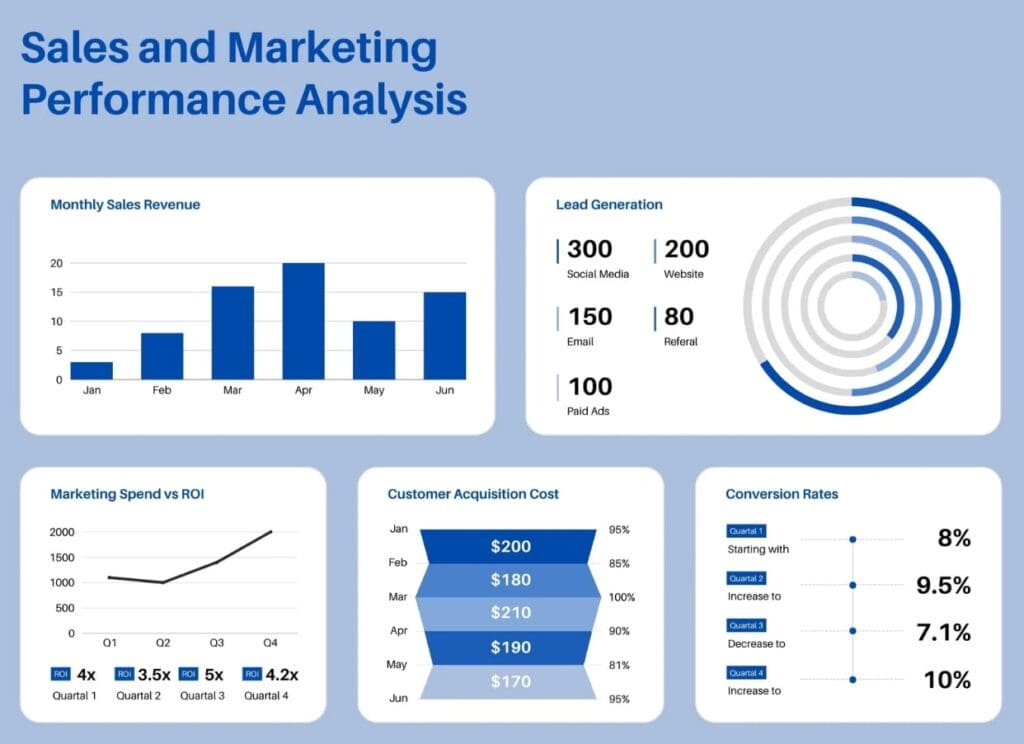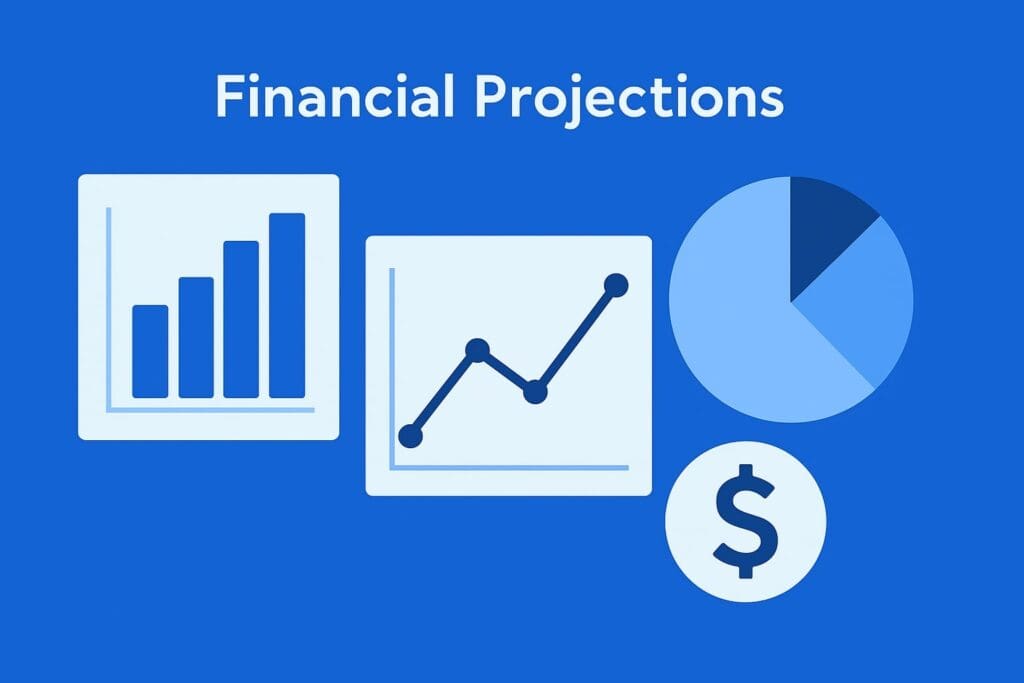Key highlights
- Discover the essential components every business plan needs to attract investors.
- Learn step-by-step instructions for creating each section of your business plan.
- Understand how to translate your business plan into an effective online presence that reaches customers.
- Access industry-specific templates that save time and ensure you include all critical information.
Starting a business without a plan is like sailing without a compass. You might move forward, but probably not in the right direction. So, if you’re wondering how to create a business plan in 2025, you’re in the right place!
This guide breaks down the process of writing a business plan into manageable steps that anyone can follow. You’ll discover strategies that improve your chances of success and templates that make the process faster.
By the end of this blog, you’ll no longer be one of those entrepreneurs who skips a business plan because it seems intimidating.
Ready to turn your business dreams into reality? Let’s start by learning the crucial sections that should be included in your business plan.
What should your business plan include?
A website business plan should include several key components that outline your business structure, goals, market position and financial projections. It serves as both a roadmap for your organization and a tool for attracting investors or securing loans. Each section builds upon the others to create a comprehensive view of your business idea and execution strategy.
Let’s start with an overview of all the sections you need to include in your business plan.
| Section | What to include | Why it matters |
| Executive summary | Brief overview of business concept, goals and financial highlights | This is often the only section investors read completely so it must capture interest |
| Company description | Your mission statement, business structure, history and brief description of products/services | Establishes your company’s identity and reason for existence |
| Market analysis | Industry trends, target market demographics, competitive landscape and market size | Demonstrates you understand your competitive advantage within the market |
| Products/Services | Detailed descriptions, development stage, intellectual property and benefits to customers | Shows what makes your offering unique and valuable |
| Marketing strategy | How you’ll reach your target market, pricing strategy, sales channels and promotional tactics | Proves you can convert market potential into actual sales |
| Organization and management | Business structure, management team, roles and responsibilities | Builds confidence in your team’s ability to execute the plan |
| Financial projections | Income statements, balance sheets, cash flow statement and break-even analysis | Validates the financial viability of your business idea |
| Funding request | Amount needed, how funds will be used and terms offered to investors | Clarifies exactly what you’re asking for from potential funders |
| Appendix | Supporting documents, research, permits and other materials | Provides evidence backing up claims made in the plan |
While this is how a standard website business plan looks like, you can always adjust it to growing needs and style. The key is ensuring you address all fundamental aspects of your business model and operations. This comprehensive approach demonstrates thorough preparation to stakeholders.
Now we’ll take a thorough look at what to include in each of these sections and how to write them.
How to create a business plan from scratch?
Writing a business plan might seem intimidating but breaking it down into manageable steps makes the process much more approachable. Follow these guidelines to create a comprehensive plan that serves your business needs.
- Start with research: Gather information about your industry, competitors and target market before writing.
- Choose your format: Decide between a traditional comprehensive plan or a lean business plan based on your needs.
- Set aside dedicated time: Schedule focused sessions to work on different sections of your plan.
- Use simple language: Write clearly without jargon so anyone can understand your vision.
- Include visuals: Add charts and graphs to illustrate key points and break up text.
- Be realistic: Base your projections on solid research rather than optimistic guesses.
- Get feedback: Have trusted advisors, mentors or professionals review your draft.
- Keep it updated: Revisit your business plan regularly as your business evolves and markets change.
- Stay focused: Remember that basic information presented well is better than overwhelming detail.
The key elements of any successful business plan include clarity, honesty and thorough research. Your plan should serve as both a strategic document for your established business and a persuasive tool for potential investors. Let’s explore each section that goes into a business plan in detail. By the end of this section, you’ll have a thorough idea about how to make business plan from scratch.
1. How do you craft an effective executive summary?
The executive summary is the first impression of your business plan and is included right at the top of your website business plan. However, you can also attempt to write this after having written the rest of the sections since it’s a condensed version of your entire plan. Here’s how to craft one:
- Mission focus: Start with a compelling mission statement that captures your purpose.
- Problem-solution pair: Clearly identify the problem your business solves and how.
- Market opportunity: Highlight the size and growth potential of your target market.
- Competitive edge: Briefly explain what makes your business unique in the marketplace.
- Team strength: Mention key team members and their relevant expertise.
- Financial snapshot: Include key financial highlights and projections.
- Funding needs: State exactly what investment you’re seeking if applicable.
- Growth vision: End with your long-term vision to inspire confidence.
Your executive summary should capture attention while providing a comprehensive overview. Think of it as your elevator pitch expanded to about one page. The goal is to entice readers to continue into the full plan with interest and enthusiasm.
2. What goes into your company description?
Your company description tells the story of your business and creates context for everything that follows in your plan. Include these in your company description:
- Mission clarity: State your mission statement and core values that drive your business.
- Business identity: Explain your legal structure and when your business was established.
- Location details: Describe your physical location and why it matters to your business.
- Historical overview: Provide a brief description of your company’s history and milestones.
- Product summary: Outline what products or services you offer or plan to develop.
- Target audience: Identify who you serve and why they need your offerings.
- Market position: Explain where you fit in your industry and your unique approach.
- Growth vision: Share your short and long-term goals for the business.
A company description should give readers a clear understanding of your business identity. It establishes the foundation for the more detailed sections that follow while conveying your passion and commitment to your business concept.
3. How to conduct a thorough market analysis?
Market analysis demonstrates your understanding of your industry and customers through detailed research and data. Here’s how to conduct and present your market analysis.
- Industry outlook: Describe market size, trends and projected growth in your sector.
- Target definition: Create detailed profiles of your ideal customer segments with demographics and behaviors.
- Competitor mapping: Analyze direct and indirect competitors and their market positions.
- SWOT breakdown: Assess your Strengths, Weaknesses, Opportunities and Threats objectively.
- Regulatory landscape: Identify any intellectual property considerations or regulations affecting your business.
- Pricing strategy: Justify your pricing based on market positioning and competitor analysis.
- Market barriers: Discuss challenges to market entry and how you’ll overcome them.
- Growth opportunities: Identify untapped segments or expansion possibilities for your small business.
A comprehensive market analysis proves you understand the environment where your business will operate. Market analysis is particularly important if you have a lean business plan focused on strategy. Your research here validates your business concept and informs your marketing approach.
Also read: How To Do Market Research for a Business Plan
4. What should you include in your product or service description?
A product or service description details exactly what you’re selling and why customers will want it. Be specific and highlight unique features. These are the points that should be present in your product or service description:
- Value proposition: Clearly state the primary benefit your product or service delivers.
- Feature breakdown: Describe key features and how they translate to customer benefits.
- Development stage: Explain where your products are in the development cycle.
- Intellectual assets: Detail any patents, trademarks or proprietary aspects of your offerings.
- Production process: Outline how your product is created or how your service is delivered.
- Sourcing strategy: Describe supplier relationship and material acquisitions if relevant.
- Future development: Share your product roadmap or service expansion plans.
- Competitive comparison: Highlight how your offerings differ from alternatives in the market.
Here you demonstrate a deep knowledge of your product or service capabilities. Focus on how your offerings solve customer problems or fulfill needs better than existing solutions, just as you would highlight unique value propositions in a business proposal presentation example. Show readers why customers will choose your business over competitors.
5. How do you create a compelling marketing and sales strategy?

Your marketing strategy outlines how you’ll attract and convert customers while your sales plan details how you’ll close deals. Here’s how to create a compelling marketing and sales strategy:
- Customer journey: Map out how prospects become aware of and eventually purchase from you.
- Channel strategy: Identify which marketing channels you’ll use to reach your target audience.
- Message framework: Define your key messages and brand positioning in the marketplace.
- Digital presence: Outline your website, social media and online advertising approaches.
- Sales process: Document your sales funnel stages from lead generation to closing.
- Team structure: Describe your sales organization and compensation structure.
- Partnership leverage: Identity strategic partners who can help amplify your marketing efforts.
- Metrics dashboard: List key performance indicators you’ll track to measure success.
Your marketing strategy should reflect a deep understanding of your target customers. It should demonstrate realistic approaches to building awareness and driving sales. Focus on strategies that offer the best return on investment given your budget constraints.
6. What operations and management details matter most?
The purpose here is to explain how your business runs daily and who’s responsible for key functions and decisions. Here’s what to include in this section:
- Organizational chart: Create a visual representation of your company’s structure and hierarchy.
- Leadership profiles: Highlight the experience and qualifications of your management team.
- Staffing plan: Outline current and future personnel needs as the company grows.
- Location logistics: Describe your facilities and why they suit your business needs.
- Production workflow: Detail your operational processes for creating products or delivering services.
- Technology systems: Explain key technologies and software that support your operations.
- Quality control: Describe measures ensuring your products or services maintain high standards.
- Partnership details: Identify key vendors, suppliers or external partners critical to operations.
Strong operations and management sections demonstrate that you have the right team and processes to achieve your company’s goals. For limited partnership structures or complex organizations, clearly define roles and responsibilities. Write the operation details in a way that builds confidence in your plans and execution.
7. How to prepare realistic financial projections?

Financial projections translate your business plan into numbers and demonstrate viability to investors and lenders. Here’s how to prepare financial projections:
- Startup costs: Itemize all expenses needed to launch your business initially.
- Revenue forecast: Project monthly sales for the first year, then annually for years 2-5.
- Expense budget: Detail fixed and variable costs, showing understanding of your financial health.
- Cash flow timeline: Create a cash flow statement showing money moving in and out monthly.
- Break-even analysis: Calculate exactly when your business will become profitable.
- Balance sheet projection: Show assets, liabilities and equity positions over time.
- Income statements: Project profit and loss for at least three years forward.
- Assumption documentation: Clearly state the research and reasoning behind your projections.
Financial projections template
Use this template to organize your financial data professionally. Fill in your specific numbers for each category.
| Financial statement | Year 1 | Year 2 | Year 3 | Notes |
| Revenue projections | ||||
| Product/service sales | $[Amount] | $[Amount] | $[Amount] | Monthly breakdown for Year 1 |
| Other income | $[Amount] | $[Amount] | $[Amount] | Interest, licensing, etc. |
| Total revenue | $[Amount] | $[Amount] | $[Amount] | |
| Operating expenses | ||||
| Cost of goods sold | $[Amount] | $[Amount] | $[Amount] | Direct production costs |
| Marketing and advertising | $[Amount] | $[Amount] | $[Amount] | Customer acquisition |
| Salaries and benefits | $[Amount] | $[Amount] | $[Amount] | All employee costs |
| Rent and utilities | $[Amount] | $[Amount] | $[Amount] | Fixed facility costs |
| Technology and equipment | $[Amount] | $[Amount] | $[Amount] | Software, hardware |
| Professional services | $[Amount] | $[Amount] | $[Amount] | Legal, accounting |
| Insurance and licenses | $[Amount] | $[Amount] | $[Amount] | Business protection |
| Other operating costs | $[Amount] | $[Amount] | $[Amount] | Miscellaneous expenses |
| Total expenses | $[Amount] | $[Amount] | $[Amount] | |
| Net profit/loss | $[Amount] | $[Amount] | $[Amount] | Revenue minus expenses |
| Cash flow | $[Amount] | $[Amount] | $[Amount] |
This template helps you organize the essential financial data that investors and lenders want to see.
Your financial statements should tell a compelling but realistic story about your business growth. Address external factors that could impact your projections and include best-case and worst-case scenarios. Remember that conservative estimates build more credibility than overly optimistic ones.
Also read: eCommerce Statistics 2025: Mobile, AI & Global Trends
8. What makes a successful funding request?
If you’re seeking investment, this section clearly outlines your funding needs and how the money will be used. Here’s what you need to successfully raise funds:
- Amount specification: State exactly how much money you need in the near and long term.
- Use allocation: Break down precisely how the funding will be spent on specific needs.
- Structure preference: Indicate your desired funding type like equity, debt or convertible notes.
- Timeline mapping: Create a schedule showing when funds will be needed and deployed.
- Return projection: Explain how and when investors can expect returns on their investment.
- Exit strategy: Describe potential future acquisition, IPO or other liquidity events.
- Risk assessment: Acknowledge potential challenges and how you plan to mitigate them.
- Legal protection: Outline your legal structure and how it protects investor interests.
Funding request template
Use this template to structure your funding request professionally. Complete each section with your specific details.
| Funding component | Details | Amount/timeline |
| Total funding needed | [Brief explanation of why you need funding] | $[Total amount] |
| Funding timeline | When you need the money and deployment schedule | [Specific dates] |
| Use of funds breakdown | ||
| Equipment and technology | Computers, machinery, software licenses | $[Amount] |
| Inventory and supplies | Initial stock, raw materials | $[Amount] |
| Marketing and advertising | Launch campaigns, brand development | $[Amount] |
| Working capital | Day-to-day operations, payroll | $[Amount] |
| Facility costs | Rent deposits, renovations, utilities | $[Amount] |
| Professional services | Legal, accounting, consulting fees | $[Amount] |
| Contingency fund | Unexpected expenses buffer | $[Amount] |
| Funding type preference | ||
| Equity investment | Percentage of ownership offered | [%] |
| Debt financing | Loan terms and interest rate expected | [Terms] |
| Convertible notes | Conversion terms and valuation cap | [Details] |
| Repayment or return plan | ||
| Expected return timeline | When investors can expect returns | [Timeframe] |
| Exit strategy options | IPO, acquisition, buyback possibilities | [Strategy] |
| Projected ROI | Expected return on investment percentage | [%] |
| Risk factors | ||
| Market risks | Competition, economic conditions | [Description] |
| Operational risks | Key person dependency, supply chain | [Description] |
| Financial risks | Cash flow challenges, funding gaps | [Description] |
| Mitigation strategies | How you’ll address potential risks | [Action plans] |
This template ensures you present a complete and professional funding request that addresses investor concerns.
A compelling funding request demonstrates a clear plan for using capital efficiently whether presented in written format or delivered as a business proposal presentation example to potential investors. It shows investors you’ve thought carefully about how to secure funding and grow their investment. Be specific about amounts needed and realistic about valuation.
9. How to organize your appendix for maximum impact?
The appendix contains supporting documents that strengthen your plan without cluttering the main sections. These are the things you should include to organize your appendix:
- Resume collection: Include detailed backgrounds of key team members and advisors.
- Legal documentation: Attach relevant permits, licenses and incorporation papers.
- Product details: Add technical specifications, photos or drawings of products.
- Market validation: Include detailed market research studies supporting your claims.
- Facilities imagery: Provide photos or layouts of your physical locations if relevant.
- Customer evidence: Add testimonials, surveys or case studies from customer segments.
- Contract samples: Include examples of sales agreements or key partnerships.
- Additional financials: Provide detailed spreadsheets supporting your financial projections.
An organized appendix strengthens your company plans by providing evidence for claims made throughout. Make this section easy to navigate by grouping similar documents and providing a table of contents. These key components add credibility and depth to your business plan.
Also read: How to Write Business Plan: Easy Templates & Expert Tips
Transform your business plan into an online presence with Bluehost
Turning your business plan into a functional online presence requires the right digital foundation. Bluehost provides an all-in-one solution that simplifies this transition for entrepreneurs.
With Bluehost eCommerce Premium plan, setting up your online business takes minutes rather than days or weeks. Our user-friendly dashboard and one-click WordPress installation make the process simple even for beginners.
The Bluehost eCommerce Premium plan covers:
- Reliable web hosting: Our optimum hosting infrastructure ensures that your site loads quickly and stays accessible to customers around the clock.
- Free domain name: A business domain name of your choice, completely free of cost for the first year.
- AI website builder: An automated website builder that creates your dream business website in minutes without you having to put in any effort.
- Easy-to-use marketing tools: Multiple tools for marketing your business including Yoast SEO plugin for content optimization and Creative Mail for email marketing.
Ready to launch your business? With Bluehost eCommerce premium your dream business is just a few clicks away!
Which business plan template works best for your industry?
Finding the right business plan template can significantly streamline your planning process. Industry-specific templates include sections and metrics relevant to your particular business type.
Here’s few industry templates that you can use right away:
Restaurant business plan template
Startup business plan template
Fashion business template
Selecting the business plan outline that aligns with your industry, saves time and ensures you address sector-specific concerns. Each template can be customized to fit your unique business needs while maintaining a professional structure.
Also read: How to Create an eCommerce Business Plan
Final thoughts
Creating a business plan might seem challenging but it’s an investment that pays dividends. This document becomes your best guide during difficult decisions and your strongest ally when seeking support. The most successful entrepreneurs revisit and revise their plans regularly as markets evolve and businesses grow.
Remember that your business plan should be comprehensive without drowning in detail. Focus on clarity, honesty and addressing the questions stakeholders will ask. The templates provided offer structure, but your unique vision will make the plan compelling.
With Bluehost, setting up your business right away is easier than ever. You won’t be needing a business plan or technical expertise for that. Just a laptop and internet will do.
Ready to bring your business plan to life? Launch your business today with Bluehost eCommerce Premium!
FAQs
Learning how to make a business plan becomes easier when you break it into smaller tasks and use templates. Start with research about your industry and competitors before drafting anything. Focus on one section at a time rather than tackling the entire document at once. Use bullet points first to organize your thoughts before expanding into paragraphs. Also, consider working with a business mentor who can review your draft and provide feedback.
Business plan examples span many industries and formats depending on their purpose. Traditional business plans, like a startup plan template, typically run 20-40 pages and include detailed financial projections, profit and loss statements, and thorough market analysis. Tech startups often use a lean startup business plan outline that fits on a single page, highlighting key value propositions, revenue streams, and a clear exit strategy. Service business plan examples frequently emphasize key members’ qualifications and operational procedures, while retail businesses focus more on location analysis, inventory management strategies, and key customer contracts.
Starting a business begins with validating your idea through thorough market research and creating a strong business plan. Next, choose your business structure—whether an LLC, corporation, or sole proprietorship—and register with the appropriate government agencies. Secure all necessary local permits, licenses, and insurance required for your industry and location. Then, set up business banking accounts and allocate your own funds wisely to establish a solid financial foundation. Develop your brand identity, including a professional logo and website, to attract your target customers. Finally, establish your operations systems, supply chain, and marketing plan before launching and acquiring your first customers. This approach ensures your new business has the business resources and strategic foundation needed for success.
A good business plan clearly communicates your business concept, market opportunity, and execution strategy. It should be realistic about challenges while demonstrating the potential for profitability and growth. An effective business plan includes thorough financial plans with sales projections based on reasonable assumptions and clear methodology. The writing should be concise, free of jargon, and professional in tone. A strong business plan anticipates questions potential lenders and investors might ask and addresses potential risks proactively. By following a step-by-step guide, you can create a strategic plan that not only helps secure funding but also ensures your business stays focused and adaptable to changing market conditions.




Write A Comment